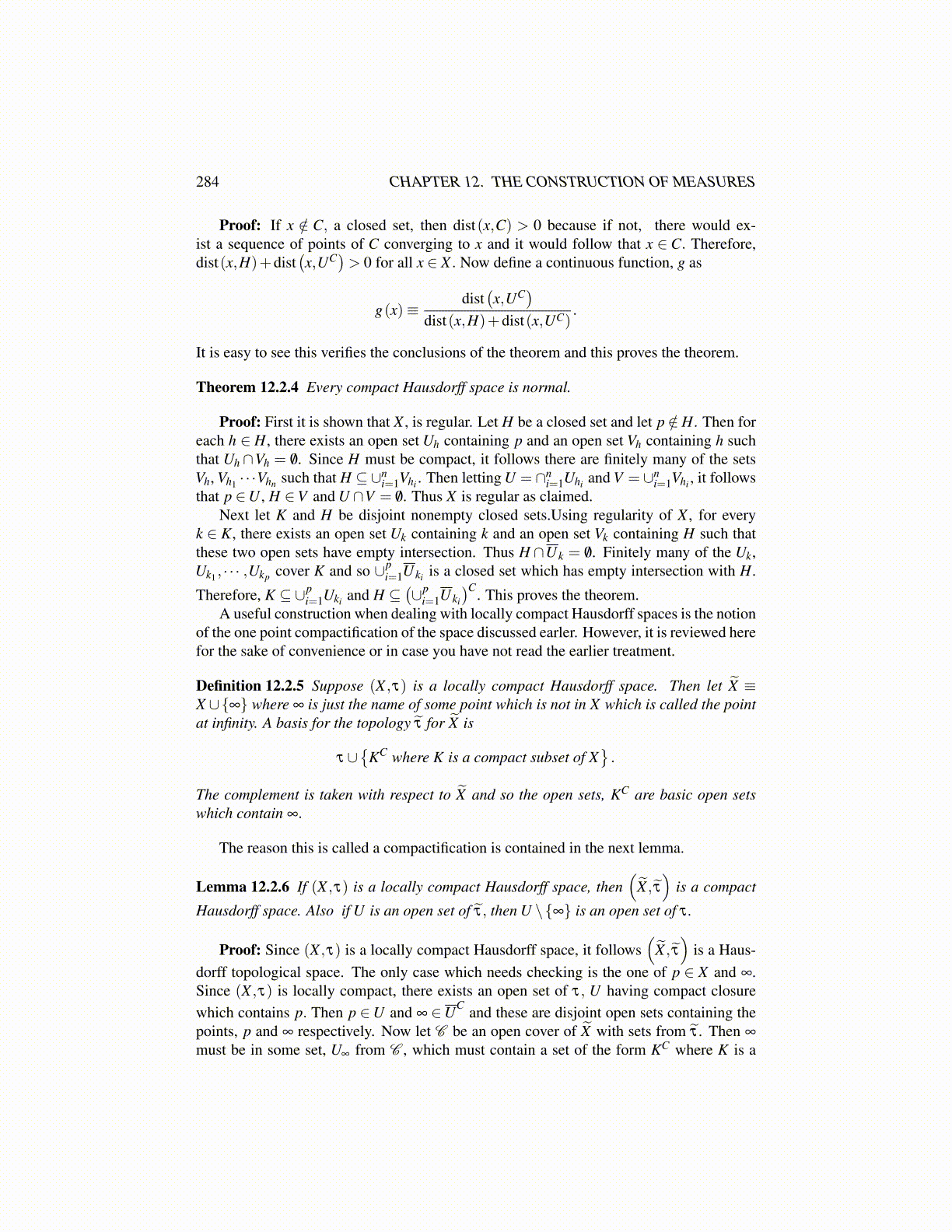
284 CHAPTER 12. THE CONSTRUCTION OF MEASURES
Proof: If x /∈ C, a closed set, then dist(x,C) > 0 because if not, there would ex-ist a sequence of points of C converging to x and it would follow that x ∈ C. Therefore,dist(x,H)+dist
(x,UC
)> 0 for all x ∈ X . Now define a continuous function, g as
g(x)≡dist(x,UC
)dist(x,H)+dist(x,UC)
.
It is easy to see this verifies the conclusions of the theorem and this proves the theorem.
Theorem 12.2.4 Every compact Hausdorff space is normal.
Proof: First it is shown that X , is regular. Let H be a closed set and let p /∈H. Then foreach h ∈ H, there exists an open set Uh containing p and an open set Vh containing h suchthat Uh ∩Vh = /0. Since H must be compact, it follows there are finitely many of the setsVh, Vh1 · · ·Vhn such that H ⊆∪n
i=1Vhi . Then letting U = ∩ni=1Uhi and V = ∪n
i=1Vhi , it followsthat p ∈U , H ∈V and U ∩V = /0. Thus X is regular as claimed.
Next let K and H be disjoint nonempty closed sets.Using regularity of X , for everyk ∈ K, there exists an open set Uk containing k and an open set Vk containing H such thatthese two open sets have empty intersection. Thus H ∩Uk = /0. Finitely many of the Uk,Uk1 , · · · ,Ukp cover K and so ∪p
i=1Uki is a closed set which has empty intersection with H.
Therefore, K ⊆ ∪pi=1Uki and H ⊆
(∪p
i=1Uki
)C. This proves the theorem.A useful construction when dealing with locally compact Hausdorff spaces is the notion
of the one point compactification of the space discussed earler. However, it is reviewed herefor the sake of convenience or in case you have not read the earlier treatment.
Definition 12.2.5 Suppose (X ,τ) is a locally compact Hausdorff space. Then let X̃ ≡X ∪{∞} where ∞ is just the name of some point which is not in X which is called the pointat infinity. A basis for the topology τ̃ for X̃ is
τ ∪{
KC where K is a compact subset of X}.
The complement is taken with respect to X̃ and so the open sets, KC are basic open setswhich contain ∞.
The reason this is called a compactification is contained in the next lemma.
Lemma 12.2.6 If (X ,τ) is a locally compact Hausdorff space, then(
X̃ , τ̃)
is a compact
Hausdorff space. Also if U is an open set of τ̃, then U \{∞} is an open set of τ .
Proof: Since (X ,τ) is a locally compact Hausdorff space, it follows(
X̃ , τ̃)
is a Haus-dorff topological space. The only case which needs checking is the one of p ∈ X and ∞.Since (X ,τ) is locally compact, there exists an open set of τ, U having compact closurewhich contains p. Then p ∈U and ∞ ∈UC and these are disjoint open sets containing thepoints, p and ∞ respectively. Now let C be an open cover of X̃ with sets from τ̃ . Then ∞
must be in some set, U∞ from C , which must contain a set of the form KC where K is a